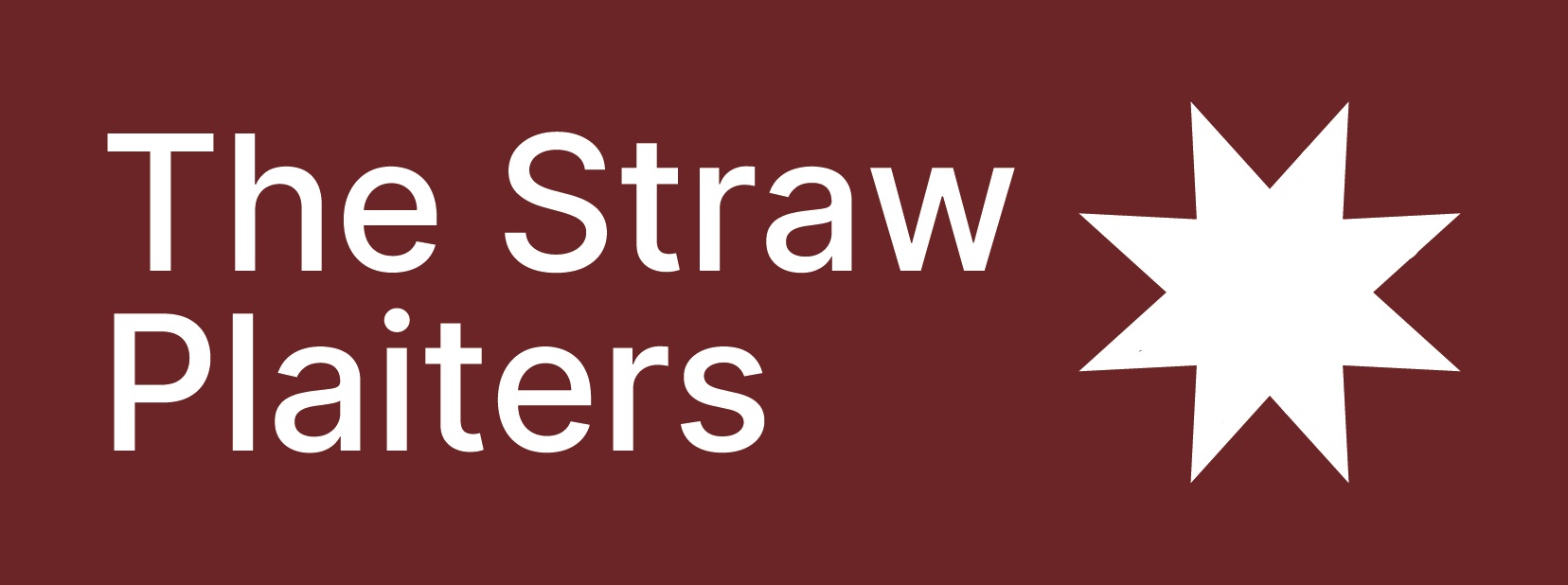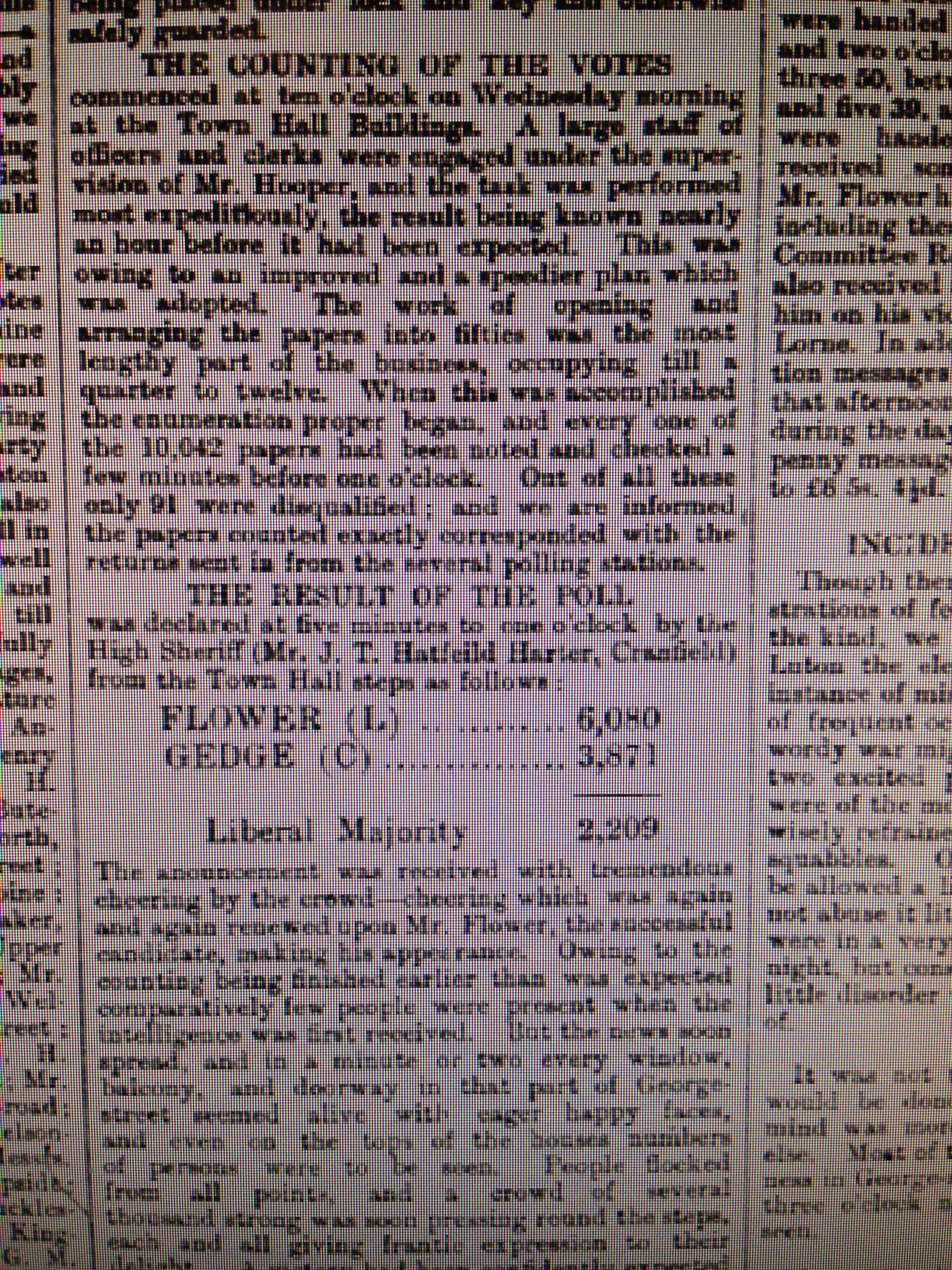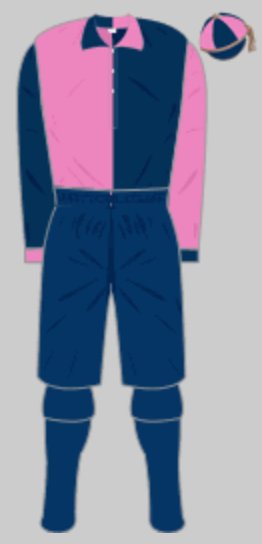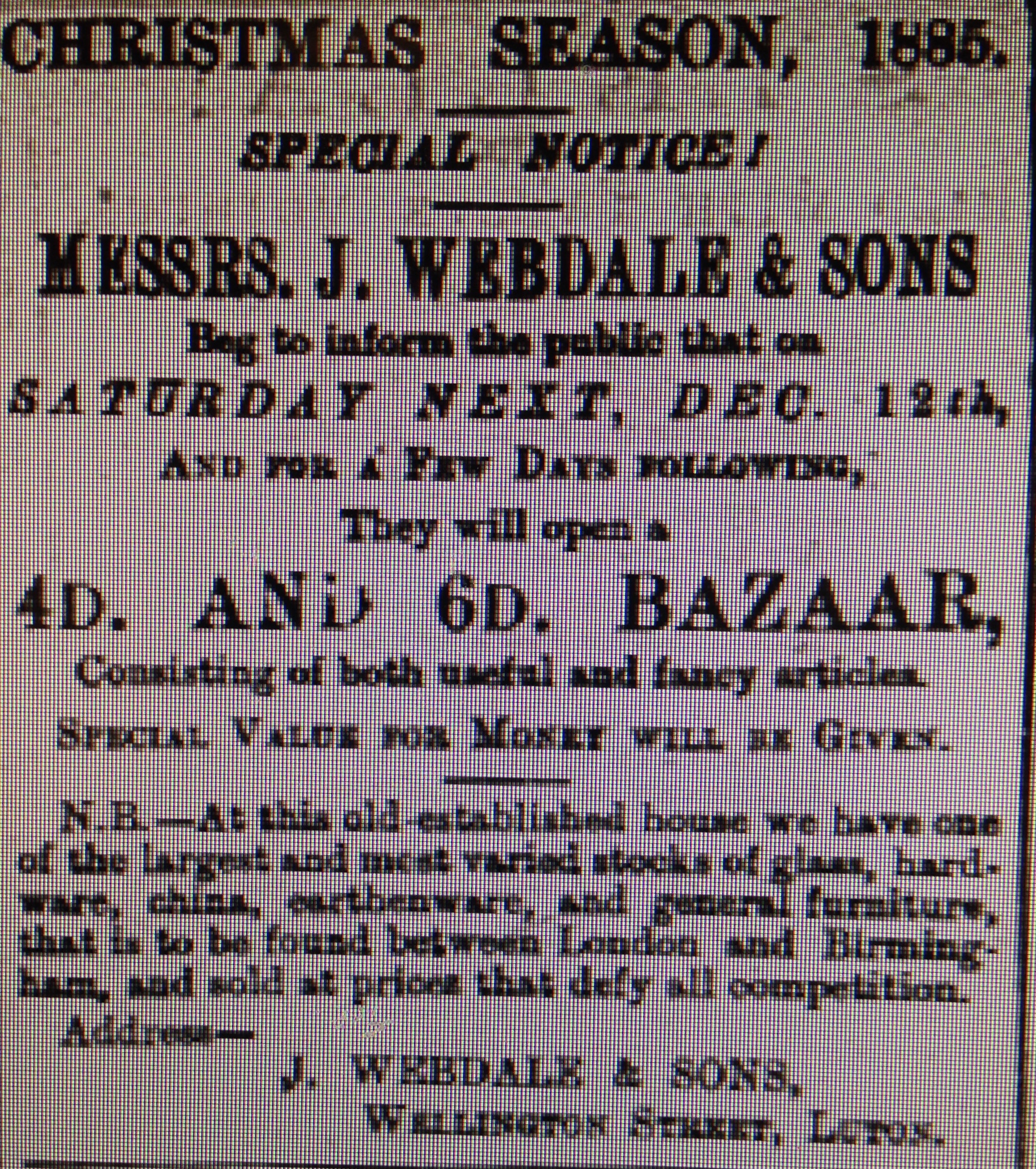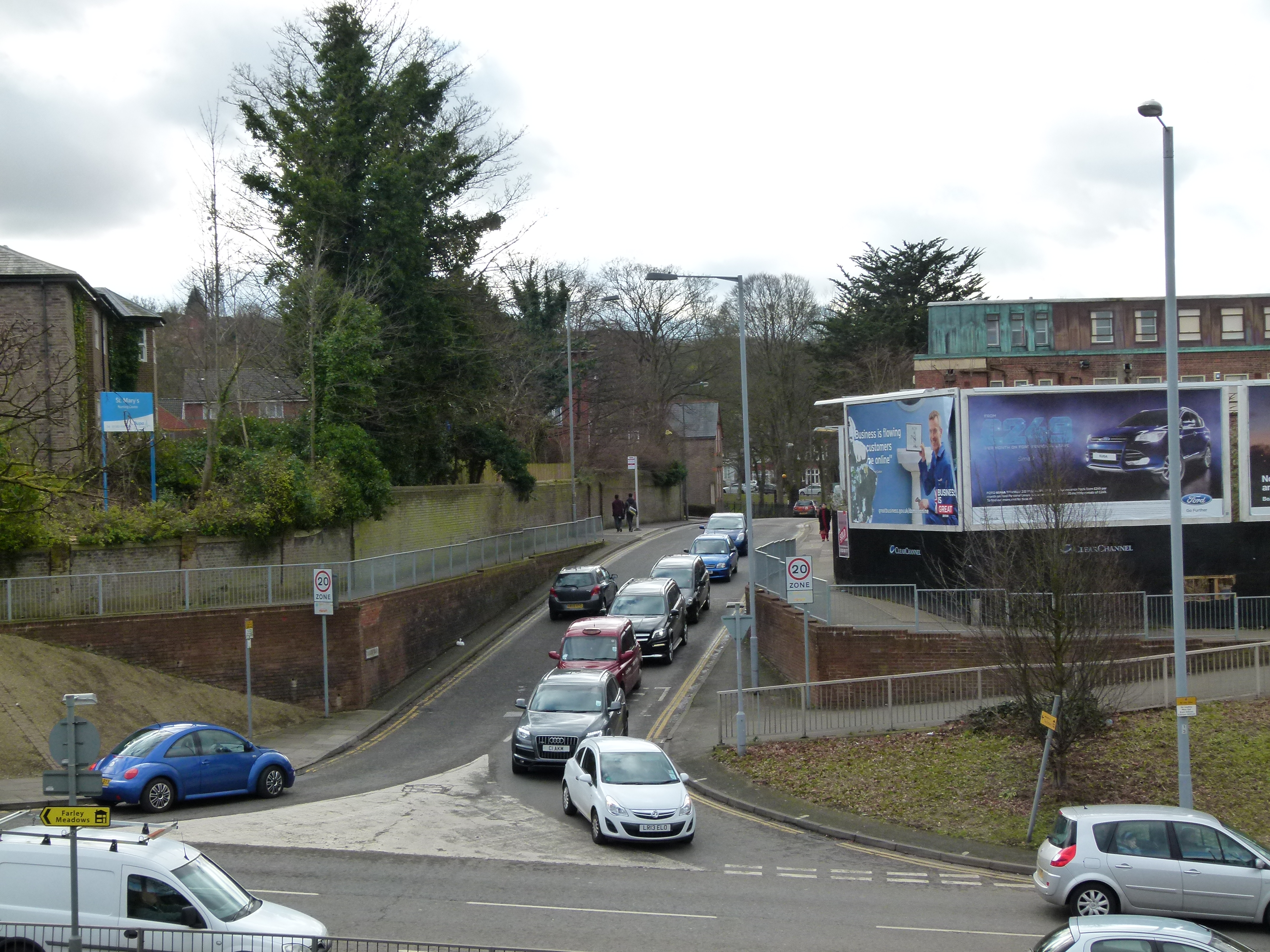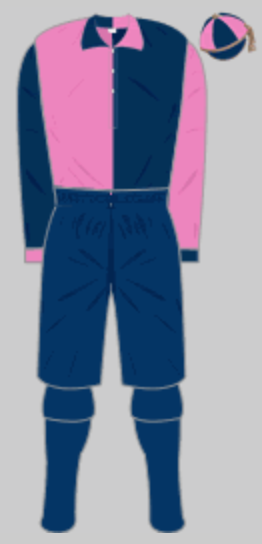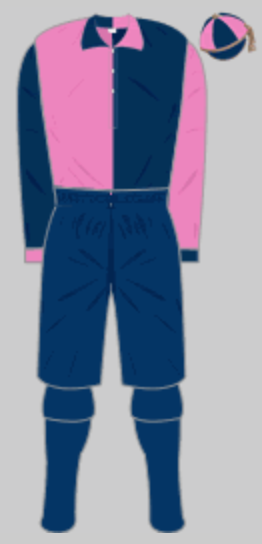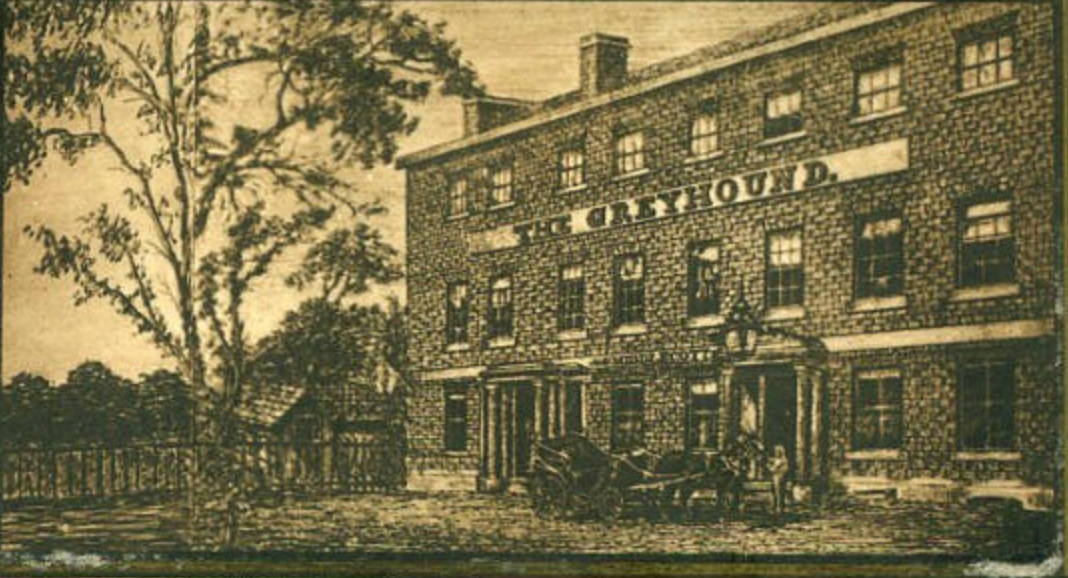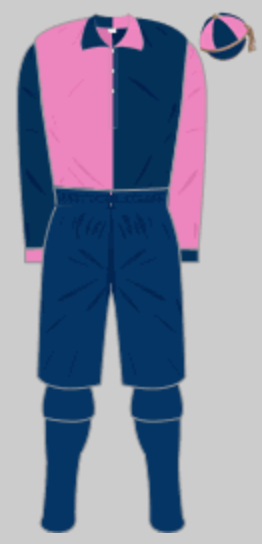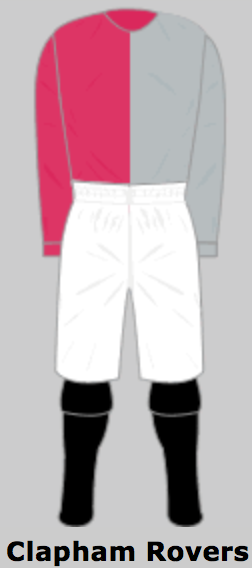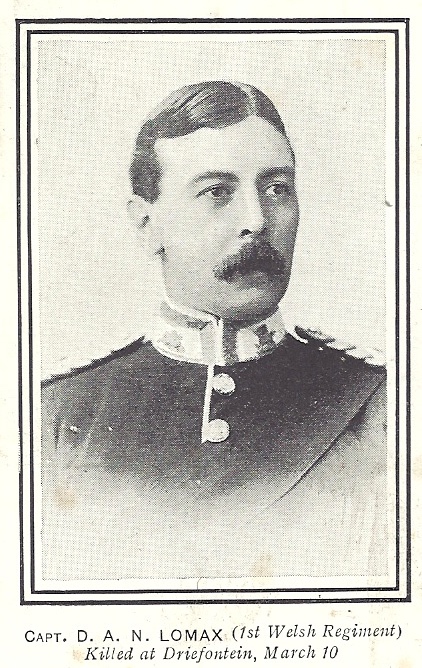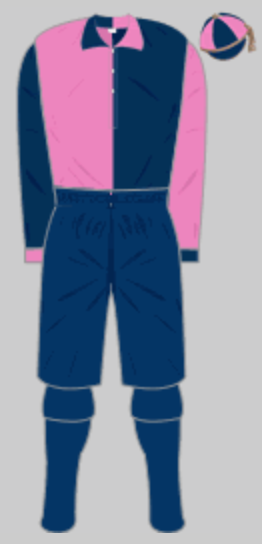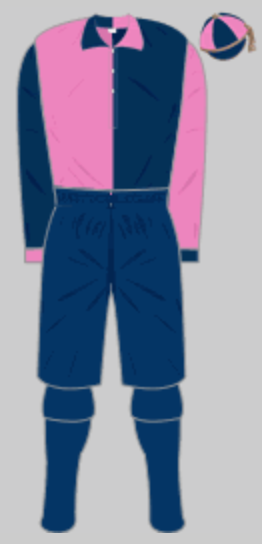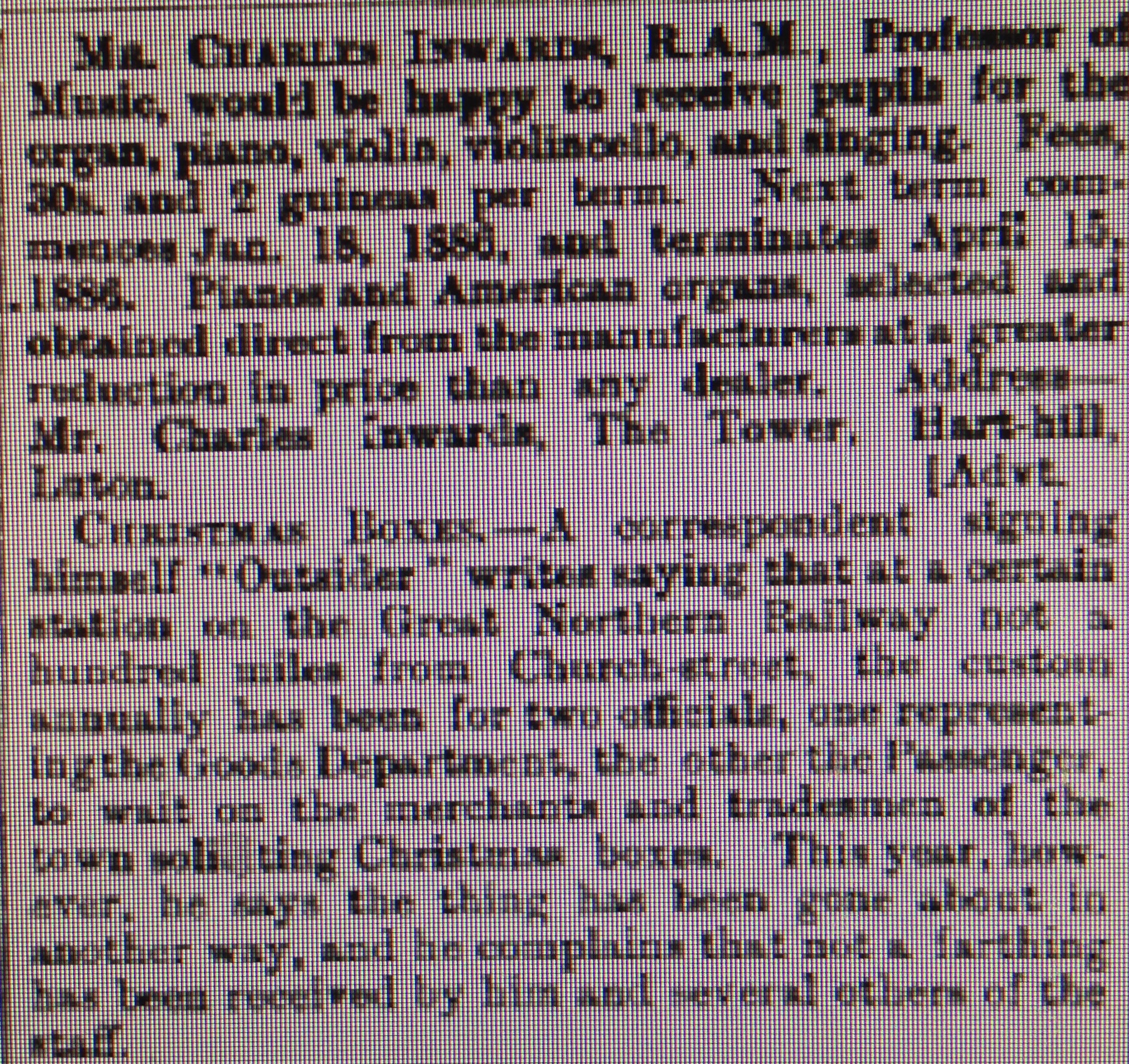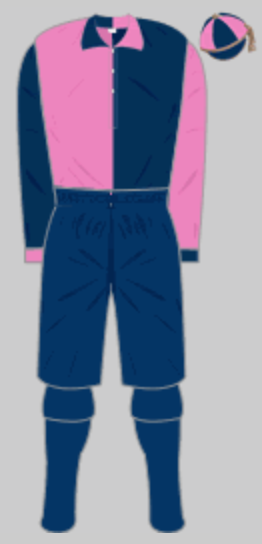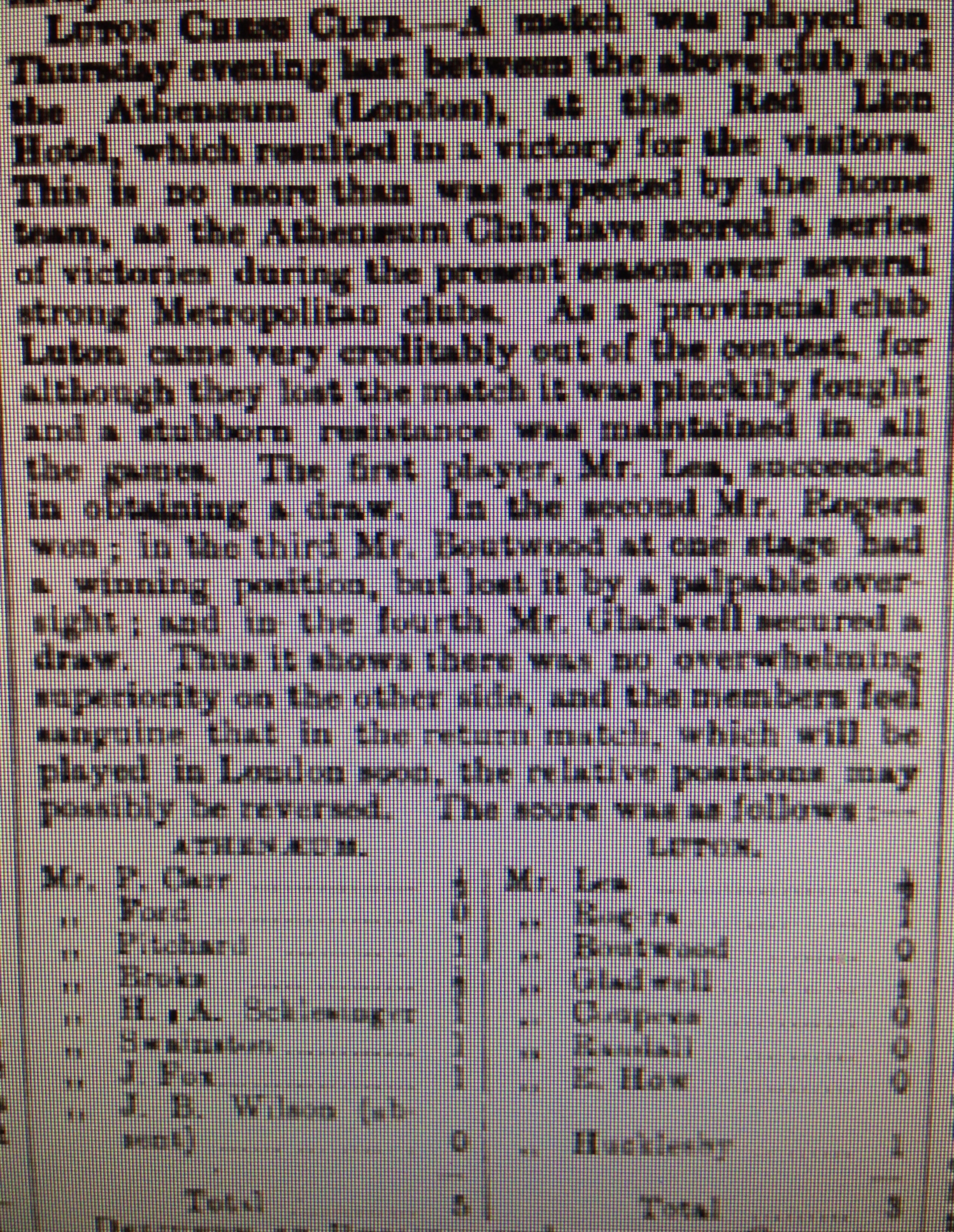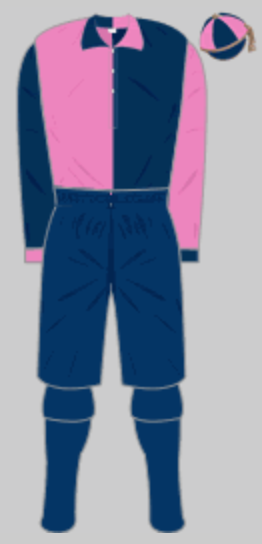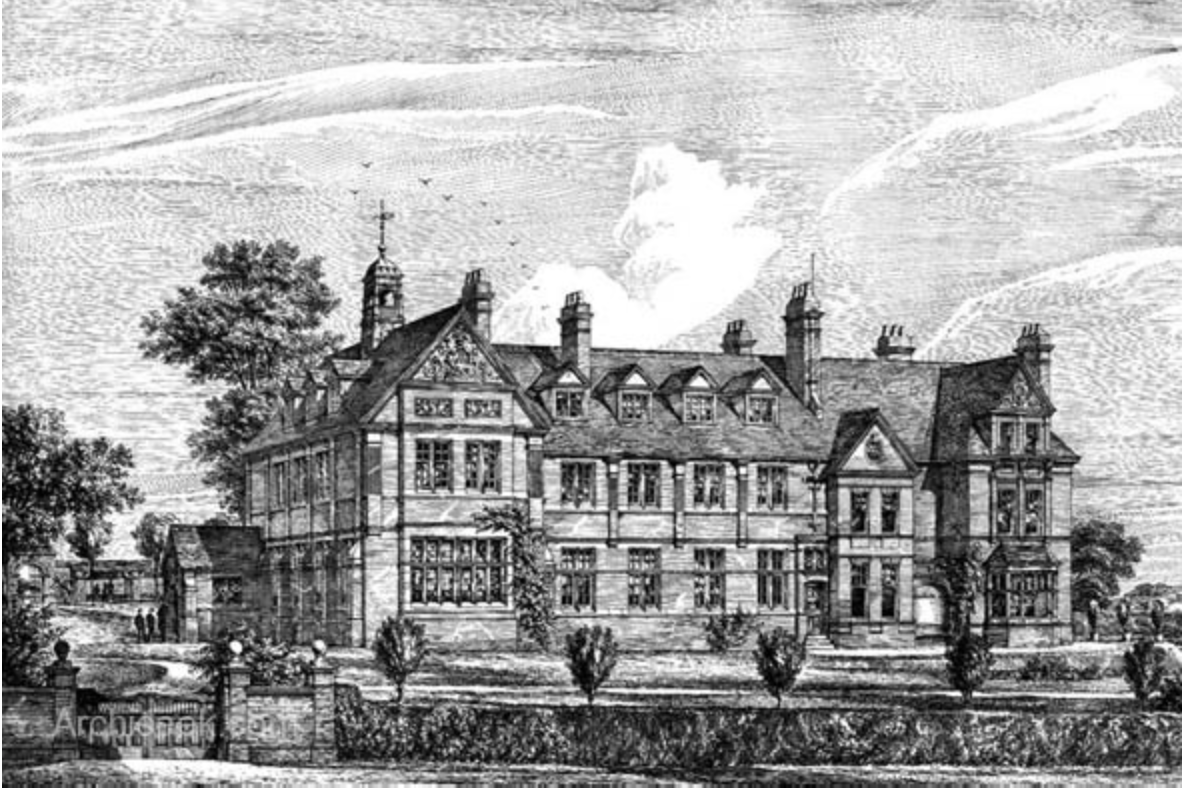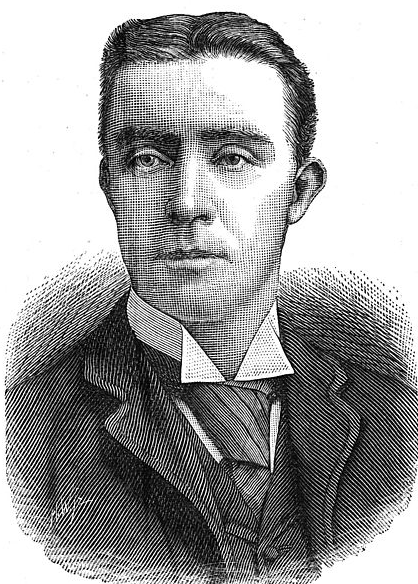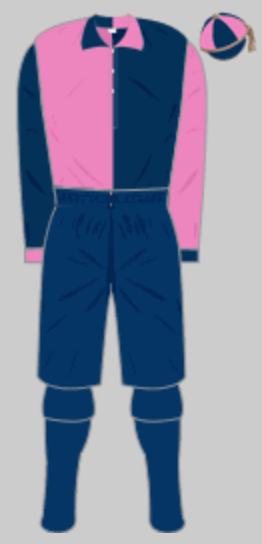CHAPTER TEN – SNOW, FROST AND WELLINGBOROUGH GRAMMAR SCHOOL
Page 2 – Luton Town v E.H. Lomax Eleven
Page 3 – Interlude, Christmas in Luton
Page 4 – Luton Town v Albany, Unity (London) and Nondescripts
Page 5 – 1886 – Luton Town v Dulwich
Page 6 – The first professional payment of a player
Page 7 – Luton Town v Clapham Rovers
Page 9 – Accident at Luton Town v Bedford match
Page 10 Luton Town v Higham Ferrers
Page 11 Wellingborough Grammar School inflict a record defeat
Page 12 Luton Town v Grove House
If you wish to read the reports on Luton Town only, please look out for the pink and dark blue kit.
The winter of 1885/86 was a cold one with frost and many snow storms cancelling games. A total of 20 games on the fixture card were lost. Lack of information has made it difficult to determine with certainty the precise games cancelled.
DECEMBER 1885
At the first committee meeting in December it was
“resolved that in the event of Mr E Lomax being unable to play at Watford, Mr Long to have power to ask Read to play in his place”.
Mr Bennett was elected umpire for the game. There would be no home game on the coming Saturday.
The meeting also resolved that
“Mr G Robinson’s bill for rolling ground be paid at once and that a reduction be asked for, the amount being rather excessive in the committee’s view”.
Finally the team for the game at Hitchin on the 12th December was chosen.
The 5th December saw Luton Town lose 1 0 at Watford Rovers. No match report was published in either local newspapers.
There were two local games. Norton College played Luton Rovers (2nd Eleven)
“on the People’s Park, and ended in a win for the latter by four goals to one”.
The third and fourth teams in Luton came up against each other when St. John’s College played away to Luton Albany. The Luton Times report describes the action;
“A match between the above clubs took place last Saturday, on the ground of the latter, before a numerous company of spectators. The game was very fast throughout, and after about twenty minutes play, Narburgh succeeded in lowering the Albany colours for the first time. During the second half two more goals were registered to St. John’s kicked by Benavides and Craig respectively. The Albany were unable to score, owing to the remarkable defence shown by the college backs. As no further points were scored, the College were left the victors by three goals to nil. For the winners, the brothers Beldam and Benavides, Craig and Narburgh showed prominently, while for the losers Miller and Buckley rendered good service. Teams,
St. John’s;- Goal – E.T. Jones. Backs – G.W. Beldam and S. Barnard. Half backs – P. Berridge, P.H. Cottam and G.L. Waldron. Forwards – J.R. Benavides C.A. Beldam (right wing), L. Narburgh (centre) (captain), E.F. Delaforce, A.R. Craig (left wing).
Albany:- Goal – G. Folks, A.E. Sanders and J. Moody. Half backs – T. Wheeler, H. Leete and E. Webb. Forwards – A.J. Deamer, H. Fullerton (right wing), A. Neill (centre), W. Miller (captain) and E. Buckley (left wing)”.
Locke Narburgh, J.R. Benavides and one of the Beldam brothers of St. John’s College would go on to play for Luton Town.
INTERLUDE – On 5th December the Luton Times announces that the Liberal, Cyril Flower was elected M.P. for Luton, obtaining 6,080 votes. It was the first general election where Luton had its own constituency. Flower served as M.P. for Luton until 1892 when he became a peer – Baron Battersea of Battersea In the County of London and of Overstrand in the County of Norfolk. He beat the Conservative opponent Sydney Gedge who got 3,871 votes. Gedge had already been beaten in 1880 at Cambridge now at Luton in 1885 and clearly became desperate because the following year the dubious hatters in Stockport elected him.
————————————————
Page 2
The Committee met on 8th December and the “Hitchin team was revised and it was resolved that they travel by train”. They also agreed to let Mr Lomax use the Dallow Lane ground on the 19th December for the purpose of a county match between Bedfordshire and another county. Mr Lomax was to be left to choose the team. I believe this refers to J.C. Lomax who was involved in the E.M.C.F.A. The committee did, however, suggest a team to represent the county.
Goal – T. Brown. Backs – Martin and G Hunt. Half backs – D. Lomax, E Lomax and Taylor Forwards – C Lomax, Bullock, Deacon, Whitby and Small. Reserves, Forward – R. Ellingham. Half back – Barrett.
Bullock is the Bedford Town player, the remainder are all from Luton.
Luton Town were due to play Hitchin and Dunstable on 12th December. However there was frost and snow all week and skating on the pools and ponds around the town so the match was “scratched”. The Committee later received a letter from Hitchin asking to play the return match at the earliest opportunity. The Committee also received a letter from “Vale of Aylesbury” but is was “not considered agreeable for a match” according to the minutes. The Committee also agreed to send two delegates to an E.M.C.F.A. meeting.
***
Luton Town had no games scheduled for 19th December. Instead they played a Mr E.H. Lomax’s Eleven. Captain Hunt was to be the referee and Mr J . Long the umpire. It was a fixture that required an admission fee as Mr Samuel Pakes and H. Boxford were elected to be the gatemen. The Luton Reporter says,
“this match was played in the Dallow Lane on Saturday afternoon and after a hard struggle resulted in a win for the club by one goal to nil. The ball having been started was quickly taken into the Town’s quarters, and by a shot by C. Lomax the goal keeper had to use his hands. The ball was the taken down to the other territory, and was kept there till half-time was called, but clearly through the excellent play of the goal-keeper, the club were unable to score. After the usual interval the ball was re-started and again went into Lomax’s quarters. Nothing however, was done. About fifteen minutes before the call of time G. Deacon made a smart run and succeeded in scoring a goal for the Club. This was the only point made, and the game ended as stated above”.
In local football, another new team appeared on this weekend – St.Matthews Bible Class played Rangers on People’s Park. The Rangers had the better of the game and won two goals to nil.
Luton Wanderers played Leighton in the Dallow Lane which
“ended in a win for the home team by two goals to nothing. Kemp started from the centre, and the visitors with a combined rush pressed the Wanderers, Pollard nearly scoring for Leighton in the first five minutes. The Luton men now got better together, and play for some time was very even. Eventually G.Smith made a brilliant run on the left, and centreing well, Hills carried the ball through and scored for the home team. Five minutes later Smith again broke away from the centre, and passing well Kemp quickly shot a second goal. Soon after, half time was called. The second half was stubbornly contested, and was remarkable for the clever manner in which both keepers defended their goals from several good shots. For Leighton, Brantom, Pollard, Gibson and Evitt were the best, while G. Smith, Ellingham, Firmin and Abrahams were the pick of the Wanderers”. Teams – Wanderers
Goal – Abrahams. Backs – Humphrey and Bird. Half backs – Bennett (captain), Widdocks, and Firmin. Forwards – G. Smith and Hills, left; Kemp, centre; Ellingham and Holstock, right.”
There was also a clip of interest to us all;
“The Wanderers FC – Mr H.G. Spratley having resigned his position as Secretary of this club, Mr Herbert Kemp, 7 Park Street West, has been appointed in his place, to whom all communication should be made”.
Was peace breaking out at long last? Was Herbert Spratley heeding the warnings from the committee and pledging himself solely to Luton Town? Or was he embroiled in another dispute, this time with the Wanderers? We have, after all, found him playing more games for Dunstable than for the Wanderers.
In other local football, Rangers beat St. Matthew’s Bible Class 2 0 on People’s Park.
Interlude – skating ended as the temperature rose.
————————————————
Page 3
There were no games on the 24th December.
INTERLUDE -The Luton Times says in the pre Christmas edition that
“Father Christmas is once again at the point of knocking at our doors…”
No mention of chimneys.
The police gave notice upon the instruction of the magistrates that all public houses and others are banned from holiday lotteries at Christmas.
Christmas Day 1885 was a quiet day, dull and cloudy with some rain.
INTERLUDE – Christmas Day in the Workhouse was one of the few highlights of the year for the “inmates” as they were known.
“Much labour had been expended on the dining-hall, which was indeed gaily and tastefully ornamented. Over the fireplace appeared the text , in bold legible characters, “Rejoice, for behold He bringeth glad tidings”, while above the doorway at the opposite end could be read “Born this day the Prince of Peace”. Drooping from the cornices all round were neat festoons of evergreens and many devices of an ornamental nature were to be observed along the walls. This was the work of the Master (Mr Brandon) and several assistants”. The Luton Reporter continues
“A number of ladies and gentlemen usually visit the House about mid-day and lend a hand in serving the poor people with their Christmas dinner. “A very substantial dinner was served, consisting of roast beef, potatoes and gravy, with a glass of beer, after which there was plum pudding ad lib. An orange was also given to each person, and the men, or at least those who wished it, received in addition a piece of tobacco and the women a small quantity of snuff”.
Photo above is of Luton Workhouse taken in February 2015
The photo above shows the Workhouse on the extreme left, Dallow Road, formerly Lane, running away from us. The site of the ground was to the right behind the billboard. The orientation of the pitch varied but was generally from left to right down the hill to where Hatters Way is today. The railway line use to run where the guided busway now runs. The ends were generally referred to as the Workhouse End and the Railway End.
Mayor Mayles also visited and there were a couple of services. Charity at Christmas was a must for the reputation of the middle and upper class Victorian family.
——————————————————
Page 4
Luton Town played Luton Albany on Christmas Day which the latter won by 3 goals to 0. It must have been a second team game as there a small mention only in the Luton Times.
Boxing Day fell on a Saturday and saw a busy day of fixtures. Luton Albany and Luton Rangers both travelled to play Bedford Town on Boxing Day. Albany came away with a 12 1 defeat. Luton Rangers faired much better.
“Considerable interest as manifested in the game, as was evidenced by the large number of spectators. Some splendid play was shown on both sides, and the match was very evenly contested all through. Bedford Town succeeded in scoring a goal just before half-time. Soon after ends were changed the Luton men passed the ball between the posts. Neither side succeeded in scoring again, so that the game was left a draw. Bedford Town: Goal – Perkins. Full Backs – Gynn, Capon. Half backs – Turvey, Jones. Forwards – Swannel and Hartford (right wing), Gearson and Fleming (centre), Perkins and Bullock (left wing). Luton Rangers; Goal – G Folks. Backs – F. Horwood and G. Peck. Half backs – J. Hopkins, G. Howard and E. Brentnall. Forwards – H. Hill, J. Northwood (right wing), F. Rumballs (centre), A. Spacey and A. Loomes (left wing)”.
There is an interesting clip from a game between Dunstable and Aylesbury Vale which says that the visitors,
“were a very heavy team and proved much too strong for the home team”.
Aylesbury won the game easily 4 0 so it sounds as if Dunstable were bullied out of the game. There is also talk of many “accidents” on the pitch but none had any serious results.
Luton Town played Unity (London) at 11am, The Luton Reporter takes up the story;
“This match was played in the forenoon of Boxing day on the ground of the former at Dallow Lane, and ended in a victory for the Town by five goals to one. Soon after the appointed time the ball was set in motion by Ellingham, and was very soon in close proximity to the Luton goal, and would, no doubt, had gone through had it not been for the very good play of the goal keeper, G. Long. Ten minutes might have elapsed and through some fine passing on the part of the Unity Beattie managed to score for them. The Luton team then buckled themselves well together, and the forwards passing well, they managed to equalise matters. From this time the Town appeared to have very much the best of the play: in fact their opponents were not “in it”, as goal after goal was scored in quick succession, and the match ended as before stated in a win for the Luton Town, (Ellingham 2; Deacon 2; C. Lomax 1). For the winners J.C. Lomax, G. Deacon, and Ellingham played well forward: Barrett (as usual) at half back: D.A.N. Lomax and Martins at back and G. Long, at goal. It might have been stated that D.A.N. Lomax met with an accident towards the end of the game, spraining a guide in his left leg, which rendered him unable to continue to play. Teams – Luton Town; Goal – Geo. Long. Backs – D.A.N. Lomax and W. Martin. Half backs – T. Lawrence, W. Barrett and T. Read. Forwards – J.C. Lomax, G. Deacon (left wing), Ellingham (centre), W. Wheeler and E. Wright (right wing). Unity; Goal – Blaigh. Backs – Harrison and Marritt. Half backs – Gaunt, Evans and Driskell. Forwards – Bowman, Whitfield, Rowland, Beattie (capt), and Burt”.
Unity were a team from Tarn and Sons, Newington Causeway, London who were a firm of tanners.
In the afternoon of Boxing Day, Luton Town played another game again against a London team, Nondescripts. This kicked off at 2.50pm so we do not know if it was the first team or the reserves or a mixture of both. W. Barrett scored the only Luton goal in a one all draw.
The newspaper announced that the game between Luton Town and Leyton next Saturday,2nd January 1886, would not take place. Instead,
“there will be practice in the club meadow (members only admitted)”.
We come to the end of 1885, an eventful year. A year in which the council was still undecided about macadmising the streets and what paving stones to lay. As today, they were subjected to criticism in the letters column of the local papers. The Council had, however, embarked on a major sewage project in the town.
——————————————————
Page 5
1886
The first Saturday of the New Year saw Luton Wanderers lose 2 0 away to Leighton.
“The Leightonians were very strong, only five of the men who played in Luton a fortnight previously being considered good enough this time. Pollard won the toss, and had the advantage of the slope, and the wind. From a good corner, C. Harvey headed the first goal, and soon after Brantom shot a goal. During the second half the Wanderers put in several good shots but these were well stopped by G. Harris the Leighton goal keeper. The brothers Harvey, C. Hodgson and Brantom were the pick of the winners while, Brooks and G. Smith showed good form for the Wanderers. Wanderers lined up; Goal – N. Other. Backs – Bird, Humphrey and Abrahams. Half backs – Brooks [Knolwes], Bennett (capt) and Holdstock, Forwards – G. Smith, A.J. Smith (left wing), Kemp (centre), Golby and Hills (right wing)”.
A small report but there are some interesting points to note. This is a rare mention of a headed goal. It obviously may have happened in previous games but was not mentioned.
We also see both sides playing with 12 men. Leighton played a 2-3-6 formation while the Wanderers went for 3-3-5. Why was “N. Other” in goal for Wanderers. We have seen the versatility of the men so why did this stranger go in goal for them. They were clearly uneasy about it as they opted for 3 backs and Leighton for 6 forwards.
Luton Town travelled to Dulwich. This is not the modern Dulwich Hamlet club who were not formed until 1893. The first mention of their pink and dark blue halves kit is 1896. Perhaps they liked the Luton kit and decided to copy it.
“This match was played at the rear of “The Greyhound” Hotel, Dulwich, on Saturday, resulting after a splendid game in a draw, no goal having been scored. From the commencement of the game it appeared quite clear that of the two teams the Town would come in first favourites from the fact that shot after shot was sent in their opponents’ goal, but without the desired effect, through the splendid goal keeping of Sugden. The Luton goal keeper fortunately had little or nothing to do, having occasion not more than twice to stop the ball passing the posts. For the Town each individual man played in remarkably good form, considering the state of the ground, which was very muddy. Luton Town; Goal – T.C. Brown. Backs – A.W. Platt and W. Martin. Half backs – W. Barrett, A.H. Taylor and T. Read. Forwards – J.C. Lomax and Geo. Deacon (left wing), F. Whitby (centre), A. Deacon and E. Wright (right wing), umpire, D.A.N. Lomax.”
The Greyhound, above, in about 1750, is reputed to have been frequented by Charles Dickens.
The Luton Reporter, which came out on Fridays, also announced that due to the frost the matches at St. Albans and at home to Kettering on 9th January 1886 will “have to be abandoned.”
—————————————-
Page 6
The first committee meeting of the New Year saw an interesting development. It was resolved that “Mr Taylor have 5/- for Dulwich expenses.” This is the first mention of a player being paid. Arthur Taylor lived in Bedford and travelled to Luton by train for home games. For this away game he would have to leave much earlier and would have probably missed work altogether that Saturday morning. The club would have paid the train fare from Luton to Dulwich. However, the train fare from Bedford to Luton for Taylor was much less than 5/-. The only conclusion we can therefore draw is that the majority of the money was for loss of wages and therefore it must be classed as a professional payment. We have no evidence that Arthur Taylor was registered as a professional with the F.A. He definitely did not meet the residence qualification as he was not born in Luton nor had he lived within six miles of Luton for two years. Arthur Holy Taylor appears to have received the first professional payment in the South of England. A payment which breached the F.A. rules. A retrospective points deduction is not anticipated.
The Committee also chose the team for the St. Albans match and
“resolved that Secretary write to team proposing that Captain Foulger be referee and we pay half expenses”.
The Kettering team was also picked and the gatemen were to be Mr Furlong and Mr Brookes. The team selected to play St. Albans would also play against Clapham Rovers.
The following week’s games were announced in the Diary of Coming Events in the Luton Reporter –
“Wanderers Football match at Dallow Lane, 2 pm” against United London Scottish and “Town Football Match at Dallow Lane, 3pm” against Clapham Rovers.
The item in the column of the paper says;
“Two good matches are announced for tomorrow (Saturday). The first is between the Clapham Rovers (who were in the third round for the Association Challenge Cup) and the Town Club in the meadow of the latter, and begins at three o’clock; the second is between the United London Scottish and the Wanderers, in the meadow of the latter at two o’clock”.
So there must have been some co-operation between Luton Town and Wanderers to arrange this staggered kick off. As it gets dark at about 4.10pm, Luton Town must have agreed with Clapham that the game would last about seventy minutes
This confirms that there was more than one pitch in Dallow Lane. We know there was an Albany Meadow for the team of the same name. Because Dallow Lane was on the edge of the town there were many fields in the vicinity, some flatter than others.
————————————————
Page 7
The timings of the kick offs on the 16th January it was not helped by Wanderers’ opponents turning up late.
“The match was played in Luton on Saturday. Owing to the late arrival of the visitors play was somewhat late in commencing. Bennett, winning the toss, decided to play with the wind and the slope, and the Scottish kicked off. Great spirit was shown, and so equal was the play that at half-time neither side had scored. Soon after, from a corner kick, Bird headed the ball backwards and scored for the Scotchmen. After this, play was very fast, and Wright ran well on the right, centred beautifully, and Kemp carried the ball through, and thus equalised matters. Strenuous efforts were now made by both sides to gain a winning point. Smith centreing well from the left, sharp play took place round the Scotch goal, and eventually Smith shot a second goal for the Wanderers, and won the match. Directly after this, time was called. McKenman, Stirling and McFie played best for the visitors, while Wright, Bird and Brooks displayed greatest form on behalf of Luton. Teams: Wanderers:- Goal – Holdstock. Backs – Bird and Davis. Half backs – Bennett (capt), Garrett and Widdocks. Forwards – Wright, R. Ellingham, Kemp, Brooks and Smith. United London Scottish lined up:- Goal – Stirling. Backs – Light and Rourke. Half backs – McKenman and Thomson. Forwards – R. Miller, Keay, H. Miller, McFie and H. Abrahams”.
Note that Scots were called “Scotch” at this time – only 10 of their players are named.
There was a long committee meeting before the Clapham Rovers match. It was thought Martin could not play so Mr Hunt would play in his place, failing that Mr Boyce.
J.C. Lomax was at the meeting despite not being on the committee. He said that;
“Mr Ernest had arranged matches on the 23rd with the “Swifts”, Eagles and Wellingborough Revellers, and asked the committee which team they would prefer to play”.
The problem was that they had promised the pitch to the E.M.C.F.A. that day. The committee left Mr Ernest Lomax to contact Mr Pretty of the E.M.C.F.A. and if they had no match arranged then the choice of team and the arrangements be left to him. This shows the burden placed on Ernest Lomax while he was at Cambridge University. The Committee were fortunate that he was so enthusiastic and willing to take on the task.
The committee approved the printers bill but they had a problem with the bill from Beecrofts who were outfitters in the town from whom the club bought their kit. It was considered they had overcharged for caps so the bill was not approved and the Secretary asked to write to them for an explanation. This is proof that the players did wear caps in this first season.
Finally the committee,
“after a discussion it was resolved by 6 to 3 that the members be admitted “free” and visitors pay 2d on 16th inst. for the C.R. match. Mr E. Lomax was chosen captain of team to play C.R. on 16th and Mr Long umpire.”
C.R. is Clapham Rovers. This was a big match and there was some debate about whether members should be allowed in free. The members, or season ticket holders, had paid 2/6 each for the season. However, a commercial decision had to be made. The club needed to make a profit to survive. On this occasion the committee chose not to upset them and allowed them in free. For the non members it was just 2d to watch the Mighty Straw Plaiters! Four committee members were assigned as gatemen so they were expecting a large crowd.
Luton Town met Clapham Rovers for their 3pm kick off. The Luton Reporter takes up the story.
“Teams representing these clubs met on Saturday on the ground of the former at Dallow-lane, in the presence of a goodly number of spectators. The Rovers having won the toss selected to play with the wind in their favour, and the ball was set in motion by D.A.N. Lomax. A few minutes had elapsed when a splendid run was made by J.C. Lomax, who passed the ball to Whitby, the latter in turn centred it to D.A.N. Lomax, who scored the first goal for the Town. On play being resumed the home team speedily drove the ball into their rivals’ quarters, and after some good passing by the wings, Ellingham also managed to get the ball through. Thereafter the Rovers, by some good play on the part of Ram and Scott, nearly succeeded in scoring, but it became apparent that the Luton men were by far the better team, as in another five minutes two more goals were added to their score by D.A.N. Lomax. The Rovers, however, buckled themselves together, and, through some rather reckless play by the Town backs, Patrick managed to gain a point for them. But the chances of the Rovers making a drawn game were very remote, as after the magnificent play by Taylor at half back, and the passing of the forwards, Whitby got the ball once more through for the Town. A few minutes afterwards the whistle sounded, and the game thus ended in a win for the Town by 5 to 1. For the winners the brothers Lomax, G. Deacon, Ellingham, Whitby, Taylor, Platt and Martin were most conspicuous, as were Hardman, Devonshire, Patrick, Ram and Scott for the losers. Teams: Luton Town – Goal – J.G. Hunt. Backs – A.W. Platt and W. Martin. Half backs – A.H. Taylor, W. Barrett and E.H. Lomax. Forwards – F. Whitby and H. Ellingham (right), D.A.N. Lomax (centre), J.C. Lomax and G. Deacon (left). Clapham Rovers – Goal – T. Read (sub). Backs – R. Coles and S. Hardman. Half backs – Devonshire and Miller (sub). Forwards – S.W. Poulton and A. C. Nixon (right), M.N. Patrick and Smith (left), E.A. Ram and H.H. Scott (centre)”.
On paper it looks a good result as Clapham Rovers were in the third round of the F.A. Cup. However, it appears that they only sent 9 men for this game as I assume it is Luton Town’s Tom Read in goal for them and Walter Miller at half-back. They had beaten the 1st Surrey Rifles 12 0 in the first round of the Cup, got a bye in the second round and were due to play South Reading in the third round but were disqualified. The club was dissolved some time in 1886 so the lack of players could be linked to that. E.A. Ram is Edward Ram who played in their 1880 F.A. Cup winning team when they beat Oxford University.
Dan Lomax, below in his 1st Welch Regimental uniform, scored the first ever Luton Town hat trick.
—————————————————-
Page 8
Thursday the 21st January;
“we experienced the severest snowstorm we have had this winter. Keen frost prevailed on Wednesday night, and at an early hour yesterday morning snow began to fall and continued to do so heavily till about mid-day. The snow lay in the streets to the depth of three or four inches, and during the forenoon the snowplough was drawn through the streets in order to clear a way for vehicles. The Corporation servants were busily engaged in carting accumulations out of the main thoroughfares”.
Luton Town’s game against Wellingborough Revellers appears to have been postponed but Wanderers did play Bedford who must have come by train.
“This match was played in Dallow Lane on Saturday in four or five inches of snow. The Wanderers’ kicked off up-hill, and play at once began to be amusing and interesting. The ball becoming clogged, the backs unable to lift it, and play for some time was very slow. Neither side scored during the first half, although Taylor put in some good long shots, one of which grased the outside of one of the posts. During the second half play was much faster as the snow was by this time somewhat trodden down. The combination of the visitors now made itself manifest, and during the last quarter of an hour they shot five goals Jones 3, Bullock and Litchfield one each). The Wanderers however, did not succeed in scoring. The home team was poorly represented as several of the Wanderers refused to turn out. For Bedford, Taylor, Heywood and Capon with the forwards played a splendid game, while Benavides, Deamer, Boyce and Widdocks did well for Luton. Teams: Wanderers; Goal – Holdstock. Backs – Boyce and Humphrey. Half Backs – Bennett (capt), Widdocks and Bird. Forwards – Benavides, Deamer, Wright, Kemp and Abrahams.
Bedford lined up: Goal – A.J. Smith. Backs – Capon and Heywood. Half backs – Taylor (capt) and Turvey. Forwards – Litchfield, Jones, Oclee, Bullock, Dudley and Webb.”
The trains must have been running on time as they are not highlighted for being late for kick off in the report. Benavides and probably Wright were St. John’s College students so they must have turned up to watch and took the place of the Wanderers who refused to play.
***
The last weekend in January should have seen Luton Town travel to Wimbledon to play Hotspur according to the fixture list. But as we have seen, the fixtures had to be confirmed nearer the time. The Hotspur game did not take place on the 30th January. E.H. Lomax tried to arrange games against the “Swifts” or the “Eagles’ without luck. The E.M.C.F.A. had arranged that Bedfordshire play Cambridgeshire which the former won 6 1.
Wanderers travelled to St. Albans and were soundly beaten 4 1. St. Albans had some ringers in their team as “4 were Watford men, 6 from Elstree district and 1 from St. Albans”.
———————————————
Page 9
The first weekend of February should have seen Luton Town play Hanover United in Wimbledon and Rushden in Luton. The pages of the Luton Town minute book are missing until 6th April so we are limited in what we know. There are no reports of these games in the local newspapers.
The second weekend sees the Luton Reporter detailing a story under the headline “Football Accident”. It continues
“On Saturday last the Town Football Club visited Bedford to play their return match with the Town Club. The match was played in a meadow on the London-road, but after the teams had been playing about ten minutes an unfortunate accident occurred. It appears that one of the Bedford right wing forwards named C. Lichfield ran at the ball when A. Martin, a Luton back, kicked at the same time, the Bedford man receiving the full force of the kick on his right leg. He at once fell to the ground and complained that his leg was benumbed, but on removing his leg guard the players found that his leg was broken just below the knee. The unfortunate man was removed to his home, and play was at once abandoned. The occurrence is rendered additionally painful by the fact that the injured man is in somewhat poor circumstances, and has a wife and two children dependent on him. We hear that a match has been arranged by the East Midlands Counties Association for the benefit of the injured man”.
The Luton Times reported a,
“serious football accident. On Saturday last, the Luton Town club went to Bedford to play a football match with the Bedford Swifts on the Goldington-road. During the game a married man named Litchfield, living at South End, had his leg broken by a kick. Martin, one of the Luton men, was charging at the ball, which Litchfield was dribbling, and kicked his opponents right leg, the blow breaking the limb. He was conveyed on a truck to the Infirmary, attended by the House Surgeon, and is progressing favourably. We understand that a benefit match for the injured man will take place on Saturday”.
Luton Town second eleven met City Ramblers in Luton on the 13th February.
“Teams representing these clubs met on the Dallow Lane ground of the former on Saturday afternoon. It was, however, no match, the play being all on one side. From the outset it was seen that the Ramblers could not hold their own against the Town men. At half-time the Luton team had three scores standing to their credit, which before the end was increased to five, whereas the visitors failed to get a single point. The Luton goals were got by Benavides 2, Ealing, Miller and Beldam one each. Teams, Luton: Goal – Boxford. backs – Cawdell and Sanders. Half backs – Davis, Inwards and Widdocks. Forwards – J. Bird (centre). Ealing and Miller (right wing), Benavides and Beldam (left wing).”
This is Luton Town second eleven with players from Excelsior, Wanderers, Albany, St. John’s College, Christ Church Institute, Victoria Rangers and Luton Rovers. I have not been able to find out which team Inwards came from. His father, Charles, was a well known musician in town and had a hire shop in Park Square. To promote his business he had an arrangement with Farmers the Music Shop who had an advert in the Luton Reporter that week. A.D. Farmer, professor of Music gives 27 King Street as the site of his “Pianoforte Harmonium and American Organ Warehouse”. He hired out and sold instruments and had a great reduction of new and copyright music, 4s. pieces, 1s 6d: 3s pieces, 1s 3d. He also gave lessons on the Organ, Pianoforte and Harmonium as well as tuning and repairing.
A new team also played that weekend, Park Ramblers, who took on Norton College on People’s Park. H. Warren scored the only goal of the game for the Ramblers. Norton College or Norton House School is still standing today. It sits on the corner of North Street and Havelock Road. See Chapter 4, page 4 for photos and more information. It existed as a school from 1881 until 1909. It has since been used by hat, clothing and catering companies. In 1885 it was described in Kelly’s Directory as being in
“the most salubrious district of Luton, adjoining the park, which affords 50 acres of recreation ground, is a modern and well-built educational establishment for the training of boys; the school-rooms, dormitories, dining-hall etc, are lofty and well lighted and ventilated and the sanitary arrangements perfect. The College prepares students for admission to Oxford or Cambridge, and for the examinations of the public offices and learned societies”.
John Thurnham was the principal.
———————————————-
Page 10
On 20th February Luton Town travelled to Higham Ferrers.
“The return match between these clubs was played at Higham Ferrers on Saturday, resulting after a very good game in a win for the Town by one goal (Wheeler) to nil. The home team were very strong – playing their cup team with which they meet Bedford next Saturday in the semi-final for the Northants and District Cup tie. Had not the Town lost one of their backs (Cawdell), who sprained his leg previous to half-time, and had to retire, and the same ill-luck befallen J.C. Lomax, who had also to retire, there is little doubt that the game would have ended still much more favourably for the Luton men. The Luton team was; Goal – H. Fryer. Backs – W. Martin and A. Cawdell. half backs – T.G. Knowles, G. Humphrey, and Barrett. Forwards – J.C. Lomax, G. Deacon, E.H. Lomax (capt), F. Whitby and W. Wheeler.”
This team is somewhat weakened and includes for the first time a new goalkeeper, Fryer. he had been elected to play in this game. The backs and half backs are new partnerships. E.H. Lomax is playing out of position as a forward.
The Northampton Mercury also reported on the game.
Neither Luton or Bedfordshire had a cup equivalent of the Northants and District Cup. As already discussed, the refusal by Luton Town to play any other team from the Borough of Luton had firmly quashed that notion.
This report on a chess match demonstrates the priorities of the newspapers in Luton at the time. A football match in Luton was a minor event. The Northampton Mercury took the opposite view.
——————————————————
Page 11
On Wednesday 24th February Luton Town played their nemesis Wellingborough Grammar School.
“Teams representing these well-known clubs met on the ground of the former of the Dallow Lane on Wednesday afternoon, in presence of a goodly number of spectators who had assembled in anticipation of witnessing an unusually good match. But in this they were somewhat disappointed. The Luton team, although it was comprised chiefly of first eleven men, did not really include the best in the club, while one of their best forwards J.C. Lomax was suffering from an injury. Their opponents on the contrary, were a very strong team, including as it did in its ranks a number of men who usually play for the East Midlands Counties Association. At first the home team showed a very plucky resistance to the onslaught of their opponents, but they soon became disorganised and apparently lost heart. In the first half Wellingborough scored twice. The Luton players it must be confessed had one or two bits of hard luck. More than once they had driven the leather well into the enemy’s territory, and on one occasion it struck the post, while the ball was forced into the keeper’s hands several times. In the second period, it may be said, the strangers had the game all their own way: and the match ended in their favour by 10 goals to nil”.
A day best forgotten. We do not have the line ups. Perhaps the same experimental team which beat Higham Ferrers was put out. Whilst they got away with it against the lesser team, Wellingborough Grammar School (above) were a real force in football in the region and anything but your best team would be exposed. The Wednesday afternoon kick off may have prevented a few from playing and J.C. Lomax played with the injury suffered at Higham Ferrers. A 10 nil home defeat to a school is humiliating whichever way you look at it but there are some mitigating circumstances. The following is from the the Wellingborough Grammar School in house magazine “The Wellingburian.”
“1885 Masters’ and Boys’ eleven. F.G. Manning, goal; A.W. Platt, A. Pretty, backs; L.C.R. Thring, J.E. Parnell and G.S. Tuxford, half backs; W.H. Garne, centre; J.B. Challen, P.A. Fryer, right wing; A.G. Henfry, T.H. Holmes, left wing.
Matches played during term 3 1885
Oct 3 v Bedford home won 3 0.
Oct 10 v Oakham home won 12 0
Oct 17 v Kettering away won 3 0
Nov 12 v Notts County home drew 2 2
Nov 14 v Luton Wanderers away won 5 0
Nov 21 v Leicester home won 7 0
Dec 5 v Hendon home won 5 0
Notts County brought down Gunn, Moore and Emmett and a most exciting game took place, the school scoring two goals in the last ten minutes and making a draw of it. The Hendon match was spoilt owing to their coming down five short, and having to play substitutes.
Mr Pretty’s knee gave way, and he only played in the first three matches.
The frost stopped two matches v Wellingborough Town and v Rushden, at the end of term.”
We can see that they had a formidable team based on those results. We have already discussed the advantages of school teams – the ability to practice regularly being the major one over teams of working men. There was also the advantages of the leadership and organisation provided by the Masters’ and the youthful exuberance of the pupils. The School had some decent masters playing for them such as Alfred Pretty, Arthur William Platt and L.C.R. Thring – the latter would play for Luton Town. However, their star players were John Bonamy Challen (below left) of Corinthians and Wales and Arthur George Henfrey (below right) of Corinthians and England. The school has no photos of their team from this era but I have located some images of Henfrey and Challen. Challen would also play 52 first class cricket matches for Somerset.
———————————————————
Page 12
The following Saturday the players had to pick themselves up for the visit to Shepherd’s Bush to play Grove House.
“These teams met on Saturday, on the ground of the latter at Shepherd’s Bush. The Town, although not so strongly represented as was expected, managed to hold their own against what was said to be the Grove House Cup Team (and with which they meet the “Volcano” in the final for the London Association Cup to-morrow), and in the end defeated them by one goal to nil. From start to finish the game was very fast. At half-time nothing had been scored by either side. On resuming, it was clearly that of the two teams the Town was the best, and being aided by the wind and the slightly declining ground they sent shot after shot into the Grove House goal. But these were stoutly kept out by Carter, who defended his position in a very efficient manner. An appeal of “hands” was given in favour of the Town just in front of their opponents goal. The ball was quickly placed by Deacon and passed by him to Brooks, who scored for the Town, very much to the surprise of the home team. Grove House now played with great determination, striving very hard to equalise matters. But the defence of the Town was far too strong for them, and the game ended as before stated. The following was the Luton Town team; Goal – W. Hills. Backs – A. Martin and T. Read. Half backs – T. Brooks, J. Bird and substitute. Forwards – G. Deacon, R. Ellingham, F. Whitby, F.W. Spivey and G. Smith.”
The quick free kick routine is nothing new and in this game directly led to a goal for Brooks.
There is nothing on the Luton Town fixture at home to Hemel Hempstead.
In local football, even the newspaper was getting the football bug. “Mr McNamara’s (Reporter Office) Eleven” played at Dunstable and drew one all.
Luton Albany won one nil at Bedford with a goal from Furlong. The Albany team was;
Goal – G. Folkes. backs – A. Sanders and Barnard. Half backs – J. Moody, S. Plummer and Stokes (sub). Forwards – P. Hill (centre), J. Furlong and Squires (Left wing), W. Miller and Buckley (right wing).
A reminder that the term “sub” or “substitute” in reports refer to replacements before the game started. A substitute during a game did not come in until 1965 for an injury only.
Wanderers drew one each at Dallow Lane with Bow from London. Ellingham was the scorer.
The Luton Reporter also states that
“Members of the Town Club are requested to take notice that the committee of the said club have passed a resolution prohibiting further practice in their meadow at Dallow Lane for the remainder of this season”.
Another indication that Luton Town had their own meadow or pitch on which they played. Also an indication of the state of the pitch after so much bad weather.
Thanks to
Mike Askham and Wellingborough School (formerly Wellingborough Grammar School)
